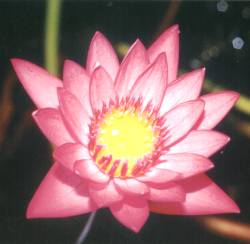Buddhism
Symbolism In Buddhism
Lotus
The lotus (Sanskrit
and Tibetan padma) is one of the
Eight Auspicious Symbols and
one of the most poignant representations of Buddhist teaching.

The roots of a lotus are in the mud, the stem grows up through the water, and the heavily scented flower lies pristinely above the water, basking in the sunlight. This pattern of growth signifies the progress of the soul from the primeval mud of materialism, through the waters of experience, and into the bright sunshine of enlightenment.
Though there are other water plants that bloom above the water, it is only the lotus which, owing to the strength of its stem, regularly rises eight to twelve inches above the surface.
According to the Lalitavistara, "the spirit of the best of men is spotless, like the lotus in the muddy water which does not adhere to it."
According to another scholar, "in esoteric Buddhism, the heart of the beings is like an unopened lotus: when the virtues of the Buddha develop therein, the lotus blossoms; that is why the Buddha sits on a lotus bloom."
The lotus is one of Buddhism's best recognized motifs and appears in all kinds of Buddhist art across all Buddhist cultures. Scrolling lotuses often embellish Buddhist textiles, ceramics and architecture.
Every important Buddhist deity is associated in some manner with the lotus, either being seated upon a lotus in full bloom or holding one in their hands. In some images of standing Buddhas, each foot rests on a separate lotus.
The lotus does not grow in Tibet and so Tibetan art has only stylized versions of it, yet it appears frequently with Tibetan deities and among the Eight Auspicious Symbols.
The color of the lotus has an important bearing on the symbology associated with it:
-
White Lotus (Skt. pundarika; Tib. pad ma dkar po): This represents the state of spiritual perfection and total mental purity (bodhi). It is associated with the White Tara and proclaims her perfect nature, a quality which is reinforced by the color of her body.
-
Pink Lotus (Skt. padma; Tib. pad ma dmar po): This the supreme lotus, generally reserved for the highest deity. Thus naturally it is associated with the Great Buddha himself.
-
Red Lotus (Skt. kamala; Tib: pad ma chu skyes): This signifies the original nature and purity of the heart (hrdya). It is the lotus of love, compassion, passion and all other qualities of the heart. It is the flower of Avalokiteshvara, the bodhisattva of compassion.
-
Blue Lotus (Skt. utpala; Tib. ut pa la): This is a symbol of the victory of the spirit over the senses, and signifies the wisdom of knowledge. Not surprisingly, it is the preferred flower of Manjushri, the bodhisattva of wisdom.